Sigma 500mm F5.6 DN OS Sport Review
Dustin Abbott
February 22nd, 2024

I was very interested in the premise of this lens when Sigma let me know about it, as this is just the kind of lens that people on all camera platforms routinely ask for – a long distance, high performing telephoto prime that isn’t ridiculously big or ridiculously expensive. The Sigma 500mm F5.6 DG DN OS | Sport is (at least on paper), the perfect telephoto option for those looking for a reasonably compact and lightweight long telephoto prime. The maximum aperture of F5.6 provides a nice balance between being large enough to be useful while small enough to keep the size (and the price!) of the lens down. Even F4 lenses at 500mm are very expensive: prices can range anywhere from $6000 (Sigma’s own 500mm F4 for DSLR mounts) to nearly $12,000 (Canon EF 500mm F4L II). The Sigma 500mm DN is much more approachable at $3000 USD; but is it worth buying? Explore my thoughts either in my video review below or by reading on.
Follow Me @ YouTube | Patreon | Instagram | Facebook | DA Merchandise | Flickr | 500px | X
Thanks to Sigma Canada (Gentec) for sending me a review loaner of this lens. As always, this is a completely independent review. *The tests and most of the photos that I share as a part of my review cycle have been done with the Sony a7RV along with the Sony Alpha 1 that serve as my benchmark cameras for Sony lenses.
__________________________________________________________________________________________________
The Sigma 500mm DN Sport is being released on Sony E-mount (reviewed here) and on the Leica L-mount consortium where it will function as a first party lens. Leica users (as usual) will have a few advantages due to restrictions put in place by Sony for third party telephoto lenses. We will detail the reality of those in this review.

There are relatively few ways to reach 500mm on Sony in a native lens. Sigma provides the most options now, as there is this new prime lens along with their 60-600mm Sport (my review here) and 150-600mm Sport (my review here) lenses. Sony has a the 200-600mm G lens (my review here) that I will reference some in this review as I happen to own it. Tamron makes a 150-500mm VC lens for Sony (my review here), and there is a recent inexpensive TTArtisan 500mm F6.3 manual focus prime that I haven’t reviewed. The Sigma 500mm DN Sport immediately has one advantage going for it – it’s maximum aperture of F5.6 at 500mm is faster than any of the alternatives, most of which are F6.3 at 500mm and one (the Tamron) has a maximum aperture of F6.7. That does come with some advantages, both in the ability to get slightly faster shutter speeds as well as providing more shallow depth of field.

Sigma made significant strides forward in some key elements of lens design (particularly for telephotos) in their release of the 60-600mm DN Sport lens. The two most important areas were in the area of autofocus (high powered HLA autofocus motor) and optical stabilizer (OS2 algorithm). Those lessons learned are on display here, as Sigma has used these technologies to make for a better, more complete telephoto prime.

Does all of this add up a telephoto prime lens that is worth investing in over the alternative zoom lenses? That’s the question of the hour…and one we’ll explore here.
Build and Handling
Typically one chooses a prime lens over a zoom lens covering the same focal length for one of three reasons (or some combination of the three). These include:
- Faster maximum aperture
- Superior image quality
- Smaller size and/or lighter weight.
We’ve already determined that the Sigma 500mm DN has a very slight maximum aperture advantage, though few would argue that the one third stop aperture advantage the prime has over the zoom lenses is meaningful. We’ll break down if the image quality favors the prime in the IQ section below, but there’s no question that the size and weight favors this prime lens. Sigma is touting it as a handholdable lens. In Sony E-mount the 500mm DN weighs 1365g (48oz) with the L-mount version slightly heavier at 1370g. The 150-600 Sport weighs 2100g (53% heavier) and the 60-600 Sport weighs 2500g (nearly 59% heavier).
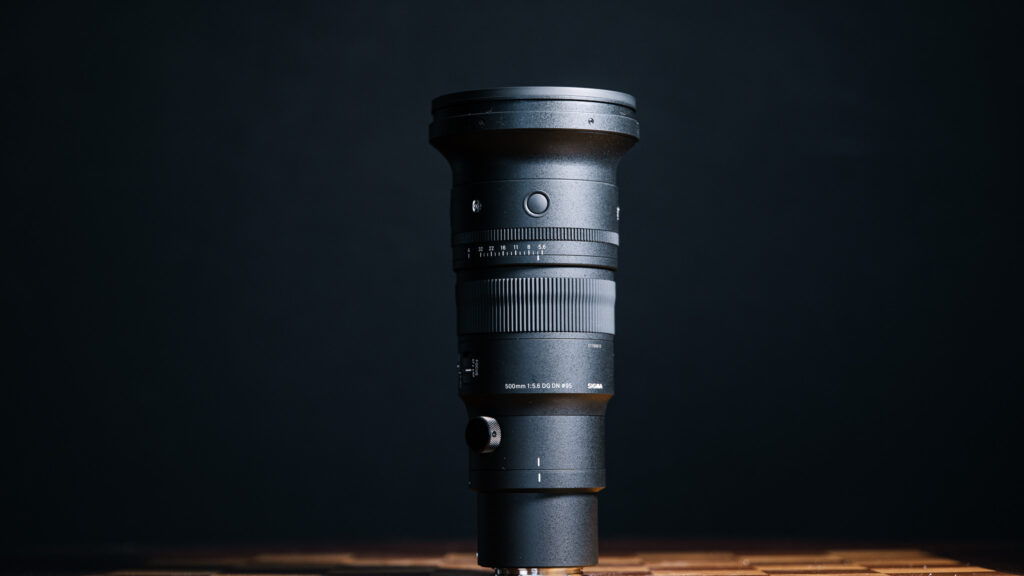
The length is 236.6mm, with the 60-600mm Sport being nearly 280mm in length while the 150-600mm is 267mm long. The lens is slightly narrower at its widest point (107.6mm/4.2″), but the difference is that the prime lens only swells out to that width near the front element, while the zoom lenses are consistently thicker throughout the barrel. I happen to own the Sony 200-600mm G lens, and you can see that the 200-600mm dwarfs the size of the 500mm DN.

That final flare to the front element means that the front filter size is fairly large. It is 95mm, which is the same as the 150-600mm and slightly smaller than the 105mm of the 60-600mm.
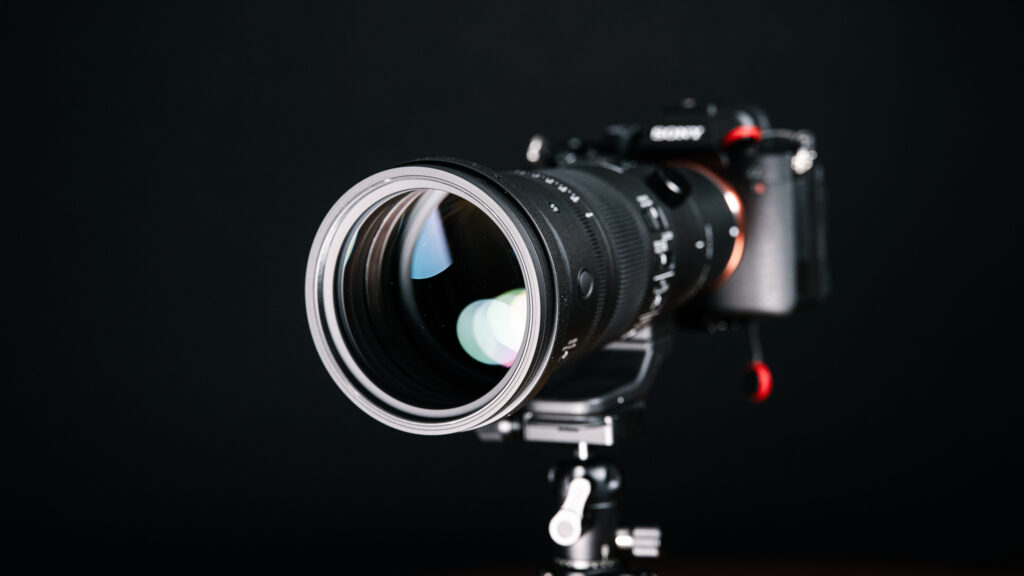
Sigma divides its lenses into three different categories: Contemporary, Art, and Sport. The Contemporary lineup gets the lowest level of build and weather sealing, while the lines are a little more blurred with the Art and Sport lenses. Typically, however, the Sport lenses do have the highest grade of weather sealing because they are the most likely to be used in inclement conditions. Many sporting events will take place regardless of weather conditions, and, surprisingly enough, most wildlife is waterproof! With that in mind, the Sigma 500mm DN Sport has Sigma’s highest grade of weather sealing. While I haven’t seen a diagram yet (I’m doing this review before the public release of the lens and before any such diagrams are available), Sigma says this of the weather sealing, “The mount connection, manual focus ring, zoom ring, switches, switch panel and exterior connection are all dust and splash resistant to prevent dust and dirt from entering the lens. Further, the front element of the lens features a water and oil repellent coating to facilitate maintenance when water droplets or dust adhere to the lens.” That sounds like a very thorough weather sealing to me.
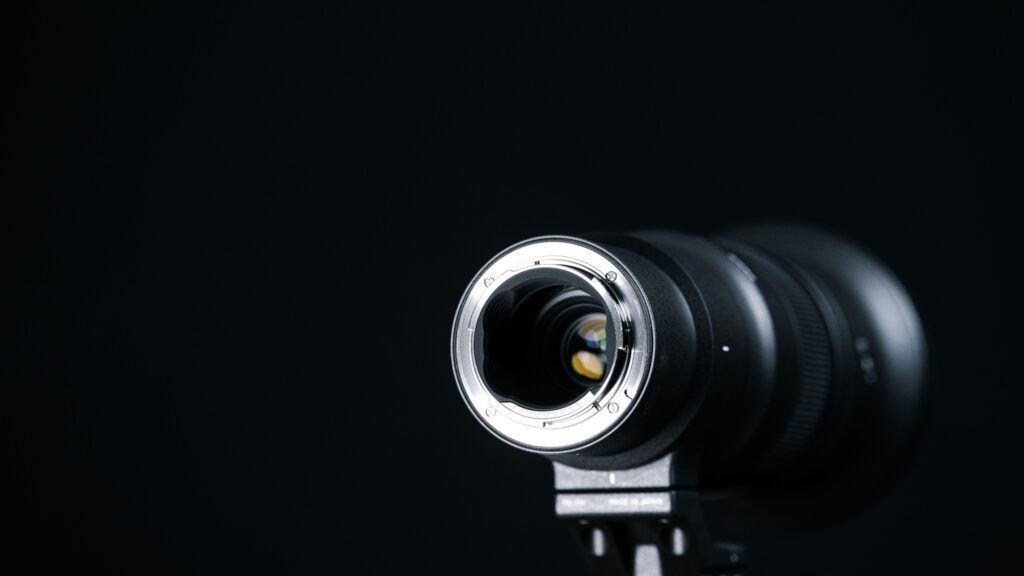
Sigma likes to mix materials on these Sport telephoto lens to try to find a balance between toughness and weight. They’ve mixed magnesium alloy metal bits with their high end plastics, which they call TSC, or “Thermally Stable Composites”. You will probably have a hard time telling which is which.
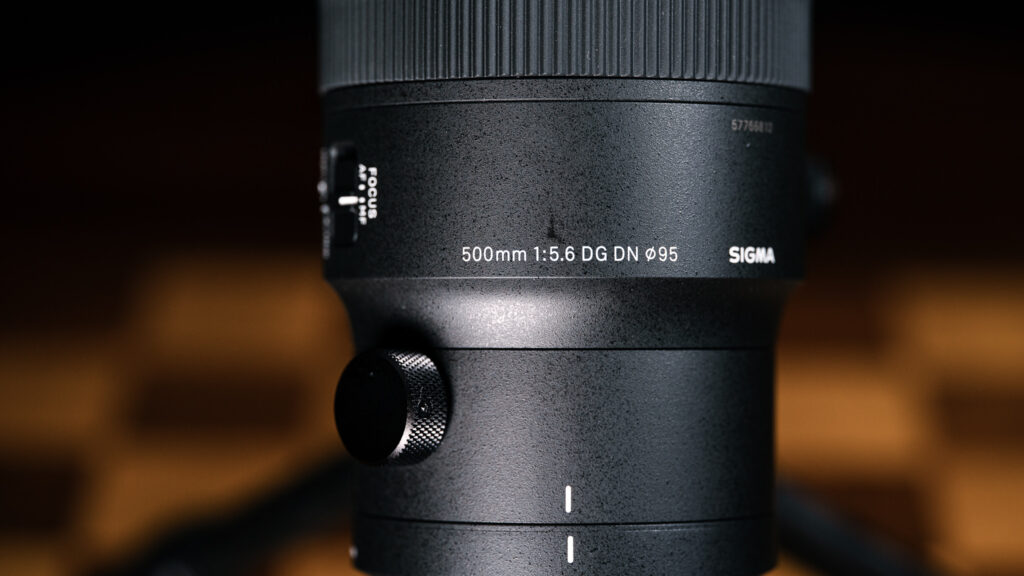
Sigma has really improved the feature set of their telephoto lenses, and they are currently as feature rich as anything out there. The 500mm DN employs a Focus Hold/Custom button in three different positions near the front of the lens, meaning that you have easy access to one regardless of how the lens is rotated. The function of that button can be set in the camera body.
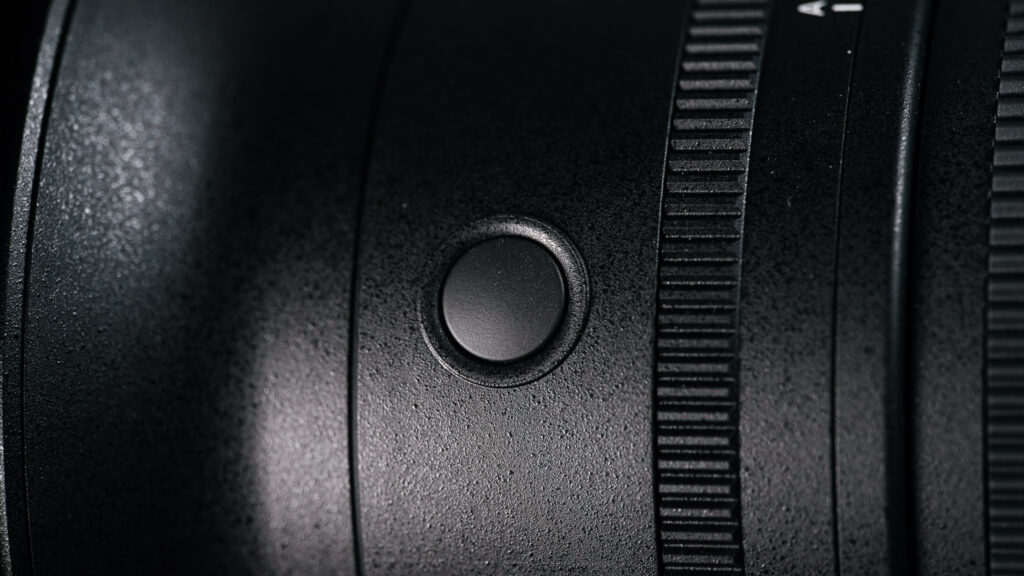
There are two switches in that same section of the lens. On the left hand is the option to click/declick the aperture ring. That’s a feature video shooters value for the ability to rack smoothly through the various aperture values. On the right hand is an iris lock that can either lock you into the manual aperture ring (if that’s your preference) or lock you OUT of it if you happen to be someone who detests aperture rings.
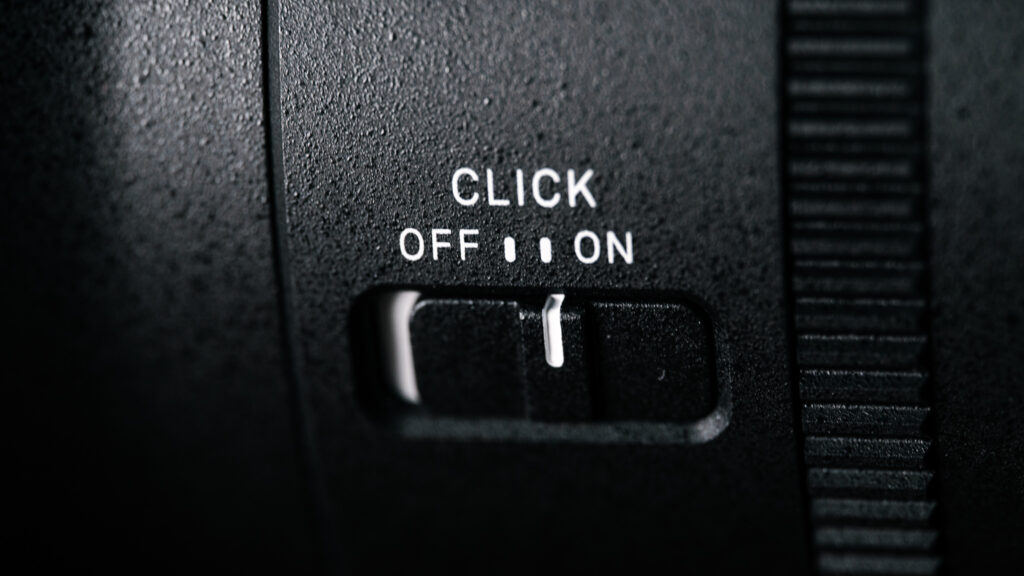
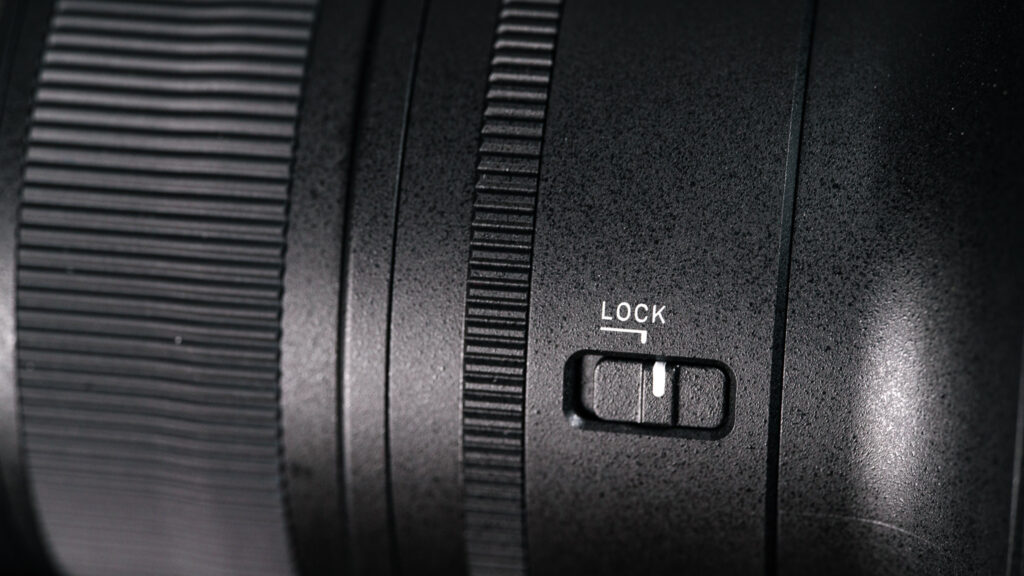
The aperture ring has markings for each one third stop detent between F5.6 and F32, though there will be no detents if you select the declicked mode. This is the only the second Sigma telephoto to include an aperture ring after the 70-200mm F2.8 Sport (my review here).

Next comes the manual focus ring, which is fairly wide (27mm), has rubberized ribs, and has a nice bevel mid ring that makes it more ergonomic.
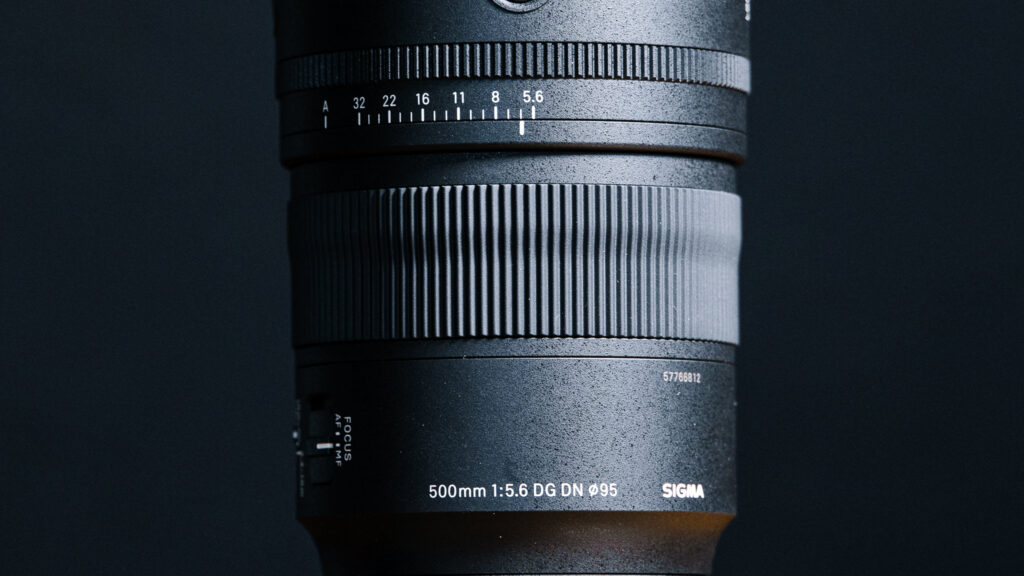
There’s a fairly standard (for Sigma) bank of switches along the left side of the lens about halfway up the lens. The top switch (AF/MF) is larger than the other three, but the other three switches are smaller and flusher to the lens barrel. The first of these is a focus limiter with three options, including Full, 10m to infinity, and minimum focus (3.2m) to 10m. You can obviously increase focus speed by employing this and eliminating part of the focus range, though I did find that focus was fast enough that I never reached for it. The third switch down is a three position switch for different OS (optical stabilizer) modes. Mode 1 is the Standard mode, while Mode 2 should be utilized while panning, as one axis of stabilization will be turned off to provide for smoother side to side panning. Sigma says of Mode 2 that, “In Mode 2, SIGMA’s Intelligent OS, an algorithm specially designed for panning shots, enables effective image stabilization even when the camera is moved vertically or diagonally, irrespective of the horizontal and vertical orientation.” In other words, a smarter stabilizer that helps stabilize panning shots without getting in the way. The third position is an OFF switch for the stabilizer.
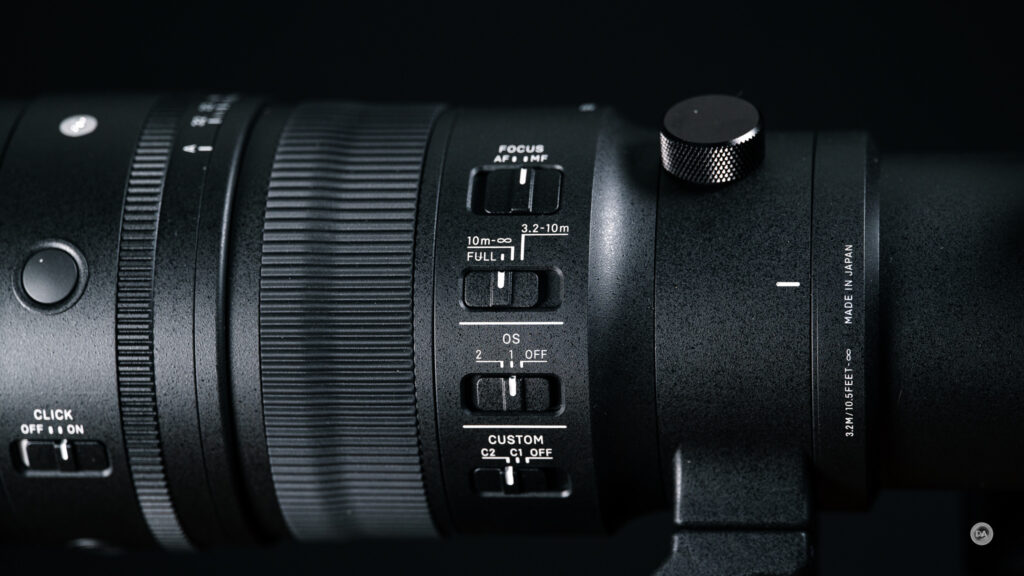
Where things get a little confusing is that the final switch is dedicated to custom modes (OFF | C1 | C2). On DSLRs you could buy the Sigma USB dock and use the Sigma Optimization Pro software to tweak some functionality (including the function of custom buttons), and, while that same functionality is available to Leica L mount customers, it isn’t for the Sony shooters who still make up the lion’s share of Sigma’s market). That means that function of these switch positions is fixed, and they are really just more OS options. C1 prioritizes stabilizing the viewfinder (probably a good option if you’re shooting video or just have shaky hands), while C2 is called “Moderate View” and seems to focus more on stabilizing the image at capture and less on stabilizing the viewfinder (a good option when panning, for example). This final option option gives you the most stable results on your shots, but in most situations having a shaky viewfinder image at 500mm just complicates things. C1 does a nice job of really keeping the viewfinder steady, though, and is a nice option for video capture.
If you are using the Leica L version of the lens and the USB dock, you’ll be able to also tweak the distance employed on the focus limiter and assign a new value to the custom buttons.

Sigma has employed their new and improved OS2 which gives a nice rating of 5 rated stops. That’s not quite the 6 stops touted on the 60-600mm, but Sigma’s OS is very nice here. A good stabilizer is hugely important in a long telephoto like this even in properly composing your shots. I was able to get this stable shot at 1/8th of a second (I got about 35% keepers at this shutter speed).

That breaks down as 6 stops of stabilization, which is pretty impressive. As before, you can’t turn off the lens’ OS without turning off the camera’s IBIS, so I can’t tell you whether the two systems work in conjunction or not. The end result is effective, and that’s what matters most.
No for some bad news.
Sony has limited teleconverter compatibility to first party Sony lenses, so unfortunately you won’t be able to use teleconverters with the 60-600DN on Sony. L-mount users can use either the TC-1411 (1.4x) or TC-2011 (2.0x) teleconverters with the lens. There are obviously a couple of advantages for Leica L-mount owners due to Sigma being part of the L-mount consortium; it is a first party lens on L-mount. These continued limitations by Sony have become more grating to me as other platforms (like Fuji and Nikon) have started to open up.
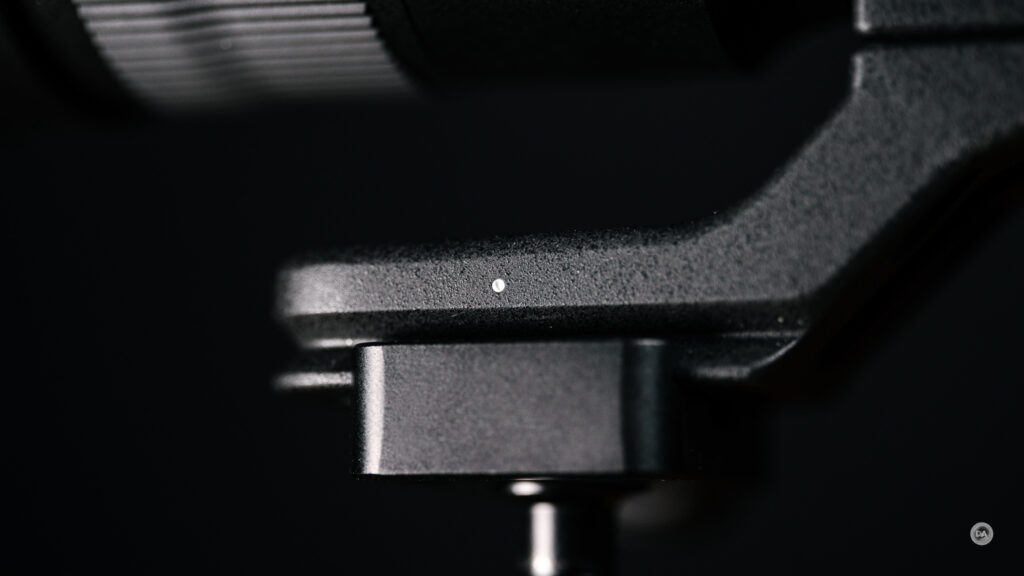
Sigma employs a tripod foot that is Arca-Swiss compatible, meaning that it can be directly mounted onto a tripod without the need for a quick release plate. For some reason Sony (and Canon) do not employ this Arca design…and I’ve never understood why. Sigma’s tripod collar is not removable (a downside), but on the upside it does employ very nice detents at the four cardinal positions, which does make it easier to rotate quickly and to find the proper position. The tripod foot itself is removable and replaceable, though this is not a tool-less operation.
There’s also a significant lens hood here (about 84mm long) that will add a significant amount of length to the lens. The large hood is actually fairly lightweight. It attached via a tension knob on the bottom (it doesn’t bayonet on), and there is a nylon cover that goes over the lens hood when you have that attached or reversed for storage. Sigma also includes a traditional pinch cap in the box, though that is hard to access if you have the lens hood mounted (it’s quite a ways in there!). The lens hood is ribbed inside and, as is common with long telephotos, has a rubberized rim that will allow you to stand the lens on the lens hood (which is much more stable a position than standing it up on the rear lens cap).
A large nylon padded case with a carrying strap is also included. Sigma does go the extra mile in the presentation of their lenses, and they are proud that their products continue to be fully assembled in Japan.
Autofocus and Video
Last year Sigma developed and launched a new high performance focus motor called HLA (High-response Linear Actuator). It was a definite improvement over the stepping motors Sigma had used in the past, and it’s not surprising that Sigma has put their best into what becomes their most expensive and highest performing telephoto lens on E-mount and L-mount to date. Here’s how Sigma describes the focus system, “A linear motor is a linear actuator that controls electromagnetic forces and can be driven freely, enabling high-speed AF.” This high powered linear motor ensures that autofocus is fast enough to back up the “Sport” claim on the lens barrel.

Autofocus speed in my focus tests was nice and snappy, as expected. The only real delay you might run into will be due to the very long focal length. Sometimes when everything is out of focus it can take a moment to grab a contrast edge to focus on because you may not be “aimed” quite right, but that’s pretty typical across the board for long telephotos.
It’s always a little frustrating to me when I get telephoto lenses for testing in the dead of winter…which seems to be Sigma’s guaranteed release window! Many of my typical wildlife subjects are either in hibernation, have limited movement, or have just headed to warmer climes for the winter! It’s difficult to find active subjects, so it is not unusual to trudge though heavy snow for hours carrying a big telephoto lens and come back with ten shots of dead leaves because I saw no living thing out there…though here’s a lovely shot of some frost covered ground coverings!

The same limitation applies to outdoor sports, as there is just not much going on outdoors in the extreme cold. I took the lens to the fieldhouse to capture some basketball, but I was quickly reminded why an F5.6 lens is not ideal for capturing sports in typical gym lighting. I was shooting at ISO 5000-6400 on my Alpha 1 and still getting shutter speeds of just 1/125th-1/200th of a second – not nearly fast enough to consistently stop action. That means that not every shot was a keeper, but my primary purpose was to test how well the lens could track action.

A 500mm prime lens is also just too long for that kind of setting. I had my back against the wall about 10m (30 feet) away from the court, and even with my subject on the far end of the basketball court I couldn’t fit their whole body in the frame. This is a “Sport” lens, but the focal length is going to be too long for a number of sports. It is better served for field type sports where the lighting is brighter (preferentially sunlight) and there is more space. In the right setting 500mm is an asset; in a typical basketball gym it is a liability.
Bottom line: this is far from ideal from testing tracking accuracy for a lot of reasons. There’s definitely some motion blur at times. That being said, even with the tight framing of a subject dribbling at high speed toward the camera, I mostly had accurately focused results. There was one minor section of about five frames (out of nearly 80, in this burst), where focus dipped away for a moment, but picked up again right after.



You can see in the sequence above the momentary lost focus (middle frame).
I found this sequence interesting, as I was trying to get a different angle on the action to see if I could mitigate the length of the lens a bit. My subject was dribbling up the court for a layup, but when he turned the corner to drive to the basket, a screen/divider that is used to separate off spaces obscured the view of the camera. What’s interesting, however, is that while the material largely blocked my view, it was just transparent enough of me to be able to very slightly see the subject. You can see from the third shot in this sequence that the camera/lens did continue to accurately track the subject – a good sign!
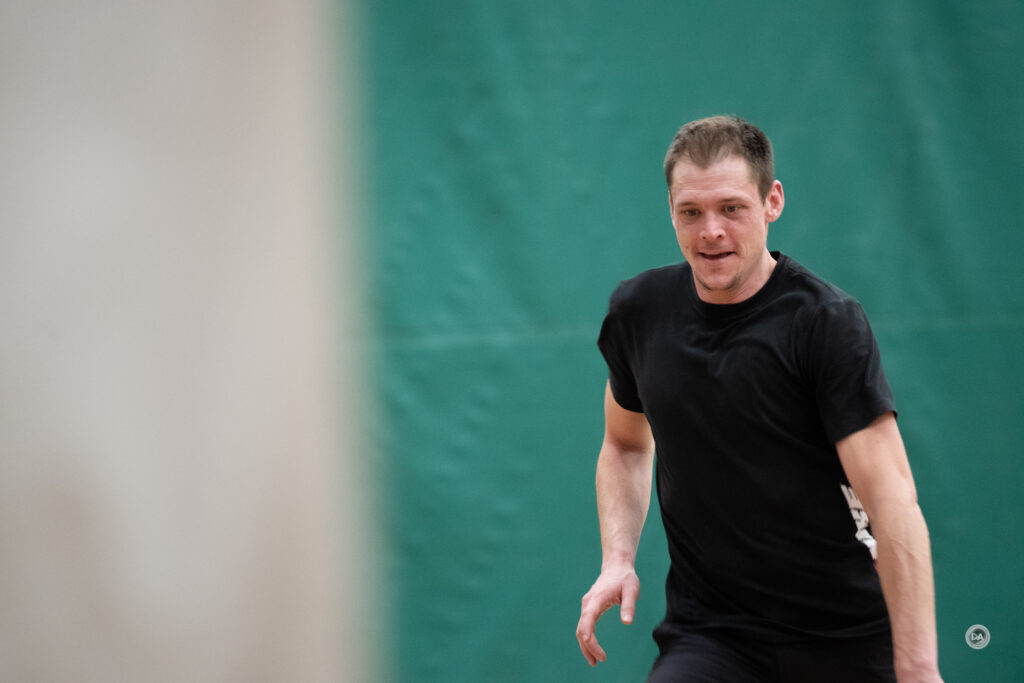


Random shots of action over a few minutes were easy to grab, telling me that autofocus is definitely fast enough for action…even in less than ideal conditions.



Bursts of Ferrari moving over the top of the snow were virtually flawless. He was moving continually (but not running) and tracking didn’t lose him over the nearly 90 shots in the sequence.

Eye detection worked well and delivered well focused results even where the depth of field is TINY from the very long focal length.

I stopped by a farm and managed to get a wide variety of beautifully focused results of the horses in their shaggy winter coats.

My video focus pull test showed smooth, confident pulls with some apparent focus breathing. I had to change my test design to accommodate this very long focal length, but I’m confident this lens will work fine for those attempting to snap focus between two subjects. Obviously tracking a subject for video shots at 500mm takes some serious skill, but that has always been the case. Most important is that the autofocus is fast and accurate enough to keep up. Sigma’s HLA autofocus system is great.
Unfortunately I have to point out a second negative reality here on Sony. The Sigma is artificially limited on Sony’s sport cameras (the a9 or Alpha 1 series) to 15FPS in burst speed, as this is another area where Sony has put its finger on the scale in favor of its own lenses. You can only get a maximum of 15FPS with any third party lens on Sony. That means that even on the new a9III where you can theoretically get up to 120FPS with a Sony lens, you will still only get 15FPS with the Sigma 500mm DN. With many cameras that’s not an issue (on my a7RV, for example), but I can get twice as many frames with my Alpha 1 and my 200-600 G than I can with the Sigma on the Alpha 1. That’s not Sigma’s fault, but it would be irresponsible of me not to mention it. This won’t be an issue on Leica L mount, though unfortunately there aren’t really any serious L-mount sports cameras that are the equivalent of the a9 or Alpha 1.
Image Quality Breakdown
The new Sigma 500mm DN “sports” (see what I did there?) an optical design of 20 elements in 14 groups, including 3 FLD elements and 2 SLD elements. As noted earlier, this is a lens that needs to perform well optically to justify its existence. Does it manage to pull it off?

That large front element means that this is a lens that has plenty of room to operate without the heavier vignette common to zoom lenses at their telephoto ends. Most zooms show some pincushion distortion and at least several stops of vignette by 500mm, but that’s far from the case here. There is no distortion to see, and what little vignette I saw was easily correctible with just a +25 (about one stop). That’s a definite advantage over zooms.
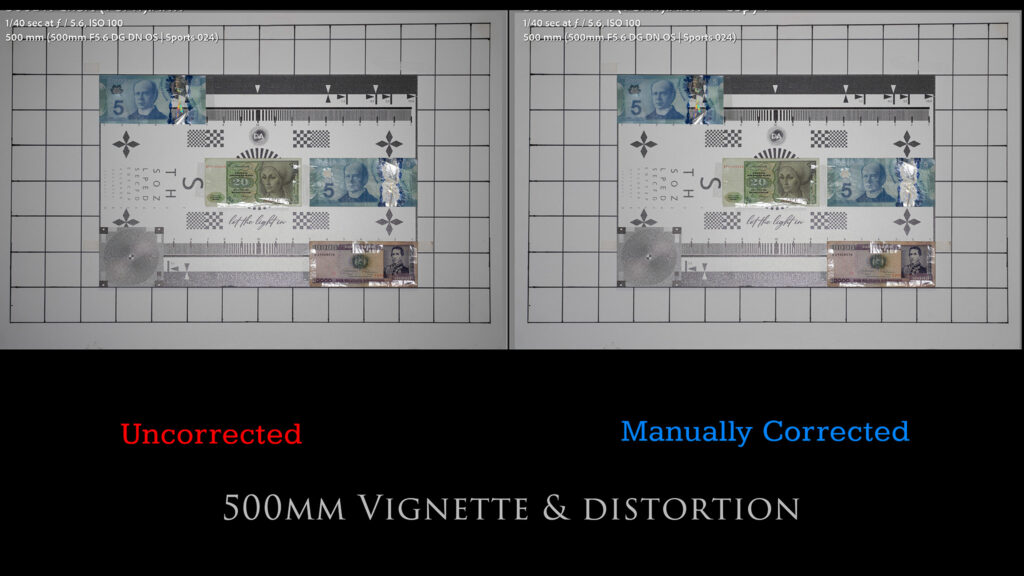
Also extremely well corrected is longitudinal chromatic aberrations (LoCA) that show up as fringing before and after the plane of focus. The Sigma 500mm DN shows essentially perfection correction here, with no fringing showing up even in this high contrast scene of sunlight coming through frost crystals on dark contrast branches. Perfect!


I also noted that I saw zero lateral chromatic aberrations near the edges of images. That typically shows up as fringing on both sides of things like tree branches.
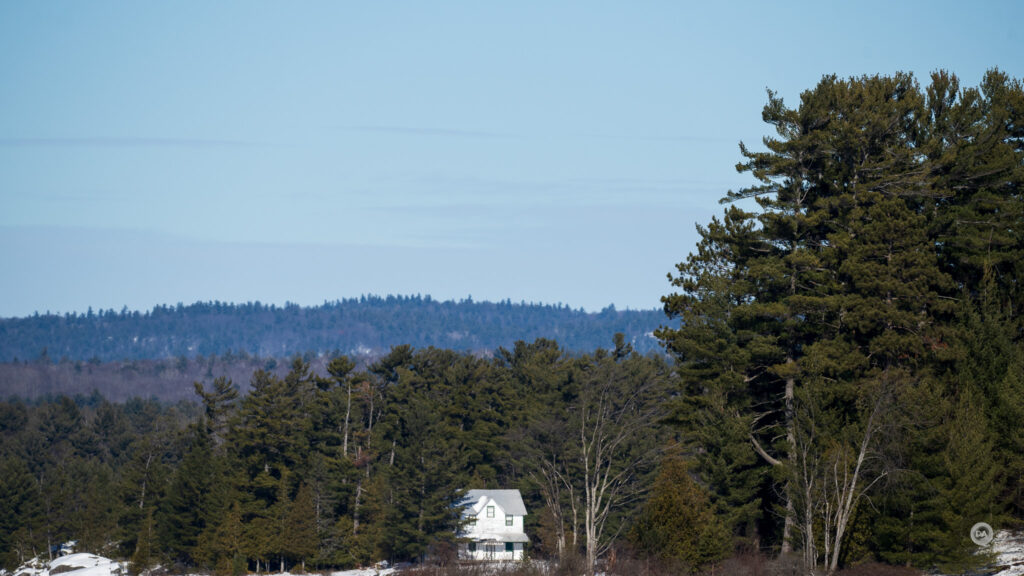

The test chart that I’ll be taking crops from can be seen in the vignette and distortion comparison above. Crops are near 200% magnification, while the comparison images below will all be shown at 200% magnification. The test camera is a 61MP a7RV, which represents the highest full frame resolution currently available. Here are F5.6 crops from across the frame:



This is an essentially flawless performance, with very high levels of contrast and resolution consistently across the frame. How about some perspective on how good that is?
I mentioned earlier that one of the ways a prime lens should distinguish itself from equivalent zoom lenses is through its optical performance. Often prime lenses can be less expensive than an equivalent zoom, but that’s not the case here. I’ll do some comparisons to both the Sony 200-600mm G lens and Sigma’s own 60-600mm (which I found slightly better than the 150-600mm Sport). Both of those lenses cost around $2000, or about $1000 less than the 500mm DN. On paper, one would expect the prime lens to outperform these zooms that cover many other focal lengths. Is that in fact the case?
Let’s start with Sigma’s own 60-600mm DN, which I consider to be the best of the long telephoto zooms that they have produced.
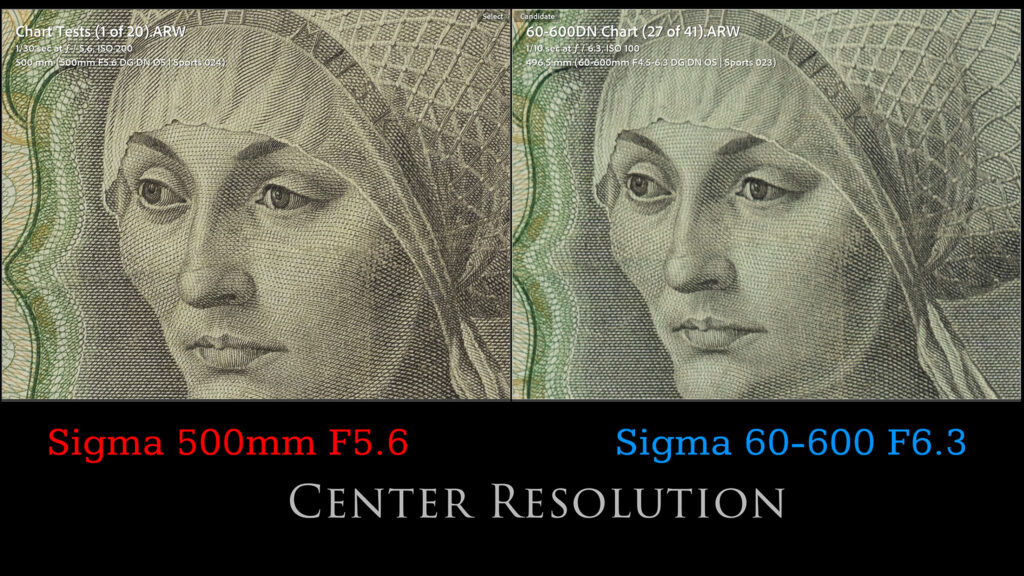
We can see that in the center of the frame the prime lens has a clear advantage over the zoom, with more detail and contrast. The prime will have a minor 1/3rd stop advantage of light gathering (F5.6 vs F6.3), but the amount of detail here shows the superior optical performance of the 500mm DN.
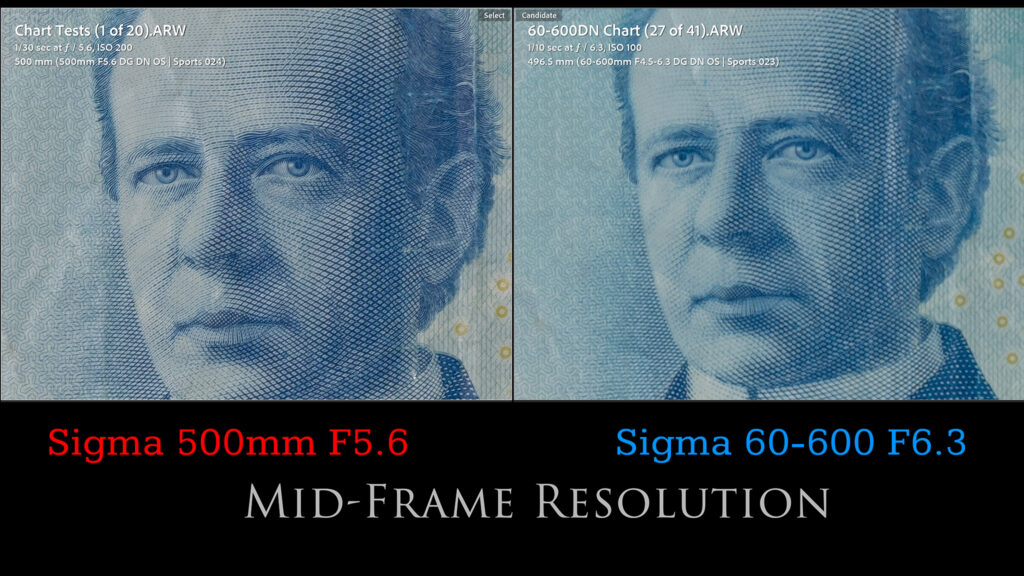
That superiority is, if anything, even more pronounced in the mid-frame. The 500mm DN is incredibly sharp there, delivering perfect levels of contrast and detail. The zoom lens is good, but looks soft and low contrast in comparison.
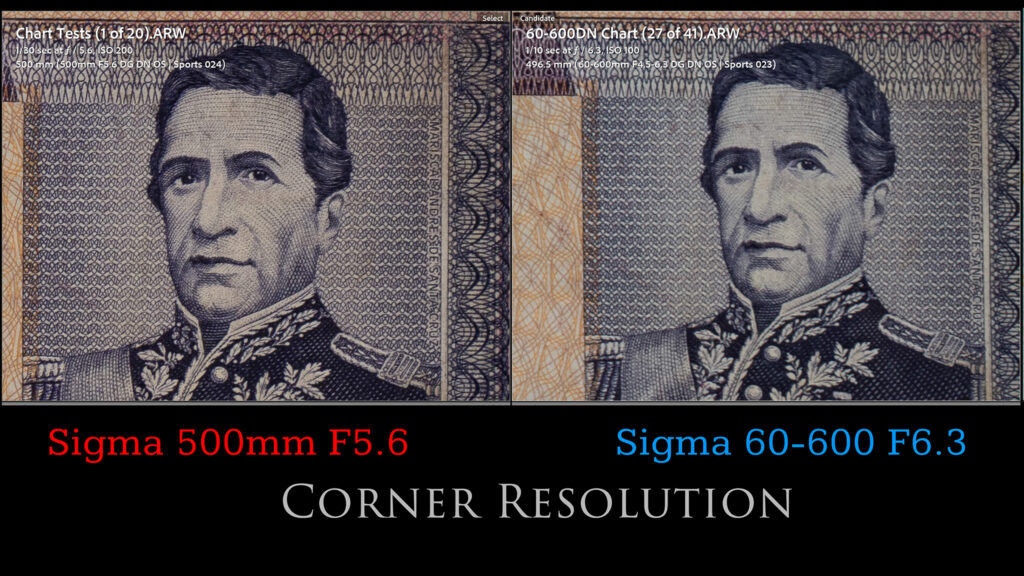
That advantage extends to the corners, which also look excellent on the prime lens. I actually think the zoom competes best here, but the contrast in particular really pops for the prime.
I’ve compared the Sony 200-600 G to at least five other competitors since its release, and I’ve felt like it won every one of the optical comparisons. It has a smaller zoom ratio than many competitors and Sony didn’t skimp on the size; they definitely went for performance. Can it compete with the Sigma 500mm DN?

The gap is a little closer here, but the Sigma prime still shows a clear advantage in the amount of detail captured in the center of the frame. Textures have more micro-contrast and “pop” more.

The advantage is again most obvious in the important mid-frame (where photos are often composed), with much more detail and contrast for the prime lens.

I would say the Sony corners are softer than the Sigma zoom, and so the advantage for the 500mm DN is even more pronounced here. It delivers a much stronger performance in detail and contrast.
By the way, when performing these tests I found I had to zoom the Sony to 518mm to equal the framing of the Sigma 500mm DN. The Sony zoom must focus breathe a bit, so the advantage between the Sony’s 600mm and the Sigma’s 500mm isn’t huge at closer focus distances (these tests were done at roughly 5 meters/16 feet).
My conclusion is that this is as good of image quality as you’re going to get at this focal length and price point…not that there are a lot of prime competitors on either Sony or Leica.
So that’s a lot of perspective on wide open performance, but is there more in the tank if you stop the lens down?
A little, but not much for a couple of reasons.
- There is more room for improvement on lenses that aren’t optimized for wide open performance. This lens is already excellent, so there isn’t much room to get better.
- A lens with a smaller maximum aperture like this has very little room for improving by stopping down because diffraction starts to offset any gains. On my a7RV, diffraction starts at roughly F6.3, which means that even at F8 there is a little diffraction effect that will intensify with each stop that the aperture is closed.
That being said, there’s a mild gain at F8 which can be seen a bit in the center:

There is a little bit more improvement (mostly to contrast) in the corners at F8:

F11 largely stays the same, but there will be increased softness after that due to diffraction. By the minimum aperture of F32 contrast is significantly reduced.

This is an incredibly sharp lens, and essentially 100% of that performance is available wide open at F5.6, though you can get similar results at F8 and very slightly less at F11. Beyond that diffraction will soften the image. That tells me that L-mount shooters should be able to get excellent results with an 1.4x Teleconverter and slightly softer results (but still very good) with a 2.0x TC.
This is a traditional telephoto prime lens, and as such (unlike some of the zoom lenses), it is not optimized for close focus performance. The minimum focus distance is 320cm (126″), which means you’ll always be working at some distance, and the maximum magnification is just 0.166x, which looks like this:

The 60-600mm Sport will allow you to achieve a very high 0.42x magnification at 200mm, so that’s obviously going to radically more flexible for up close work.
One advantage the prime lens will have over any of the competing zooms is that the slightly larger maximum aperture combined with Sigma’s ability to engineer for just one focal length means nicer looking bokeh. This is a lens capable of producing beautifully blurred out backgrounds even working at some distance.

Near minimum focus you will be able to completely blur out backgrounds, creating a very soft end result.

But even at a further distance and with a more complex background, the out of focus blur is pleasing. This is particularly impact for wildlife work, as this shot represents a more typical working distance than the closer shots above:

You will probably rarely use this lens for landscape work, but it is very capable of compressing scenes and bring distant vistas much closer.

It’s also interesting for compressing elements together, like in this industrial scene:

This is the type of focal length that means that the sun will rarely be in the frame, but, if it is, the Sigma 500mm DN shows a solid amount of flare resistance.



Colors look nice and rich, with good accuracy.

There’s not really anything to complain about here optically. There’s not really any optical flaws that I can point to. It’s a fantastically sharp, has great contrast, nice bokeh, and no fringing. You couldn’t really ask for more. Check out the image galleries through this link to see more photos.
Conclusion
The Sigma 500mm F5.6 DN OS | Sport is a very welcome addition to their lineup. This is the very type of lens that I’ve heard many, many photographers ask for over the years. Relatively small and lightweight, high performing, good autofocus and image stabilization, and a relatively affordable price. On paper, it is pretty much perfect.

And, for Leica L-mount shooters, it may just be that. It’s compatible with extenders, there’s a full range of customization options, and there are no artificial limits to performance. On Sony (by far the largest market for the lens) there are some very unfortunate limitations that are not Sigma’s fault. No teleconverters is a big one, as it means one can’t grab 700mm at a very manageable F8 (1.4x TC) or a whopping 1000mm at F11 (2.0x TC). You can activate APS-C mode on Sony cameras, which jumps you to a 750mm equivalent, though at a lower resolution point (26MP on my a7RV, but lower on lower resolution bodies). Those using Sony’s sport bodies like the Alpha 1 or a9 series will also find the burst rate artificially capped at 15FPS (which is still fast, but not nearly as fast as some of these bodies are capable of). Sony’s arbitrary limitations on third party lenses are starting to sting, and this otherwise excellent lens is hurt by these limitations perhaps more intensely than any other third party lens to date.
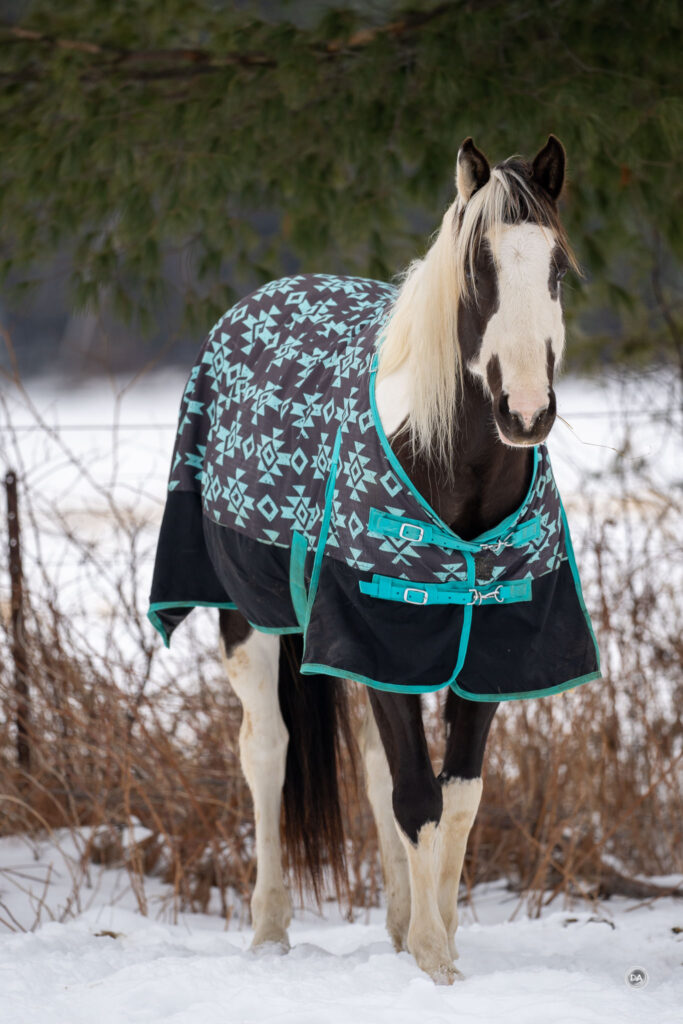
If you are willing to accept those limitations, however, then this is a unique telephoto prime that checks a lot of boxes. Well built, fast autofocus, feature rich, awesome optical performance, and light enough to carry around without need a monopod or a bodybuilder’s arms. And, while it isn’t cheap at roughly $3000 USD, that is half the price of what their older 500mm F4 lens for DSLRs was, so, considering inflation, that’s a reasonable price. It takes skill to use a 500mm prime well, but this is a lens that can reward you with great images for that money!

Pros:
- Very nice build quality
- Excellent weather sealing
- Rich feature set
- Much lighter than zoom lenses that cover the equivalent focal length
- Fast autofocus motor
- Very effective Optical Stabilizer
- Clearly sharper than zoom lenses that cover 500mm
- Less vignette and distortion than zoom lenses
- No fringing of any kind
- Nice bokeh
- Good flare resistance
Cons:
- About 50% more expensive than Sigma’s own 60-600mm Sport lens
- On Sony no teleconverter compatability
- On Sony burst rate limited to 15FPS on sport cameras
_________________________________________________________________________
GEAR USED:
Purchase the Sigma 500mm F5.6 DN Sport @ B&H Photo | Adorama | Amazon | Camera Canada | Amazon Canada | Amazon UK | Amazon Germany
___________________________________________________________________
Purchase the Sony a7RV @ B&H Photo | Adorama | Amazon | Camera Canada | Sony Canada | Amazon Canada | Amazon UK | Amazon Germany
__________________________________________________________________
Purchase the Sony a7IV @ B&H Photo | Adorama | Amazon | Camera Canada | Sony Canada | Amazon Canada | Amazon UK | Amazon Germany
_________________________________________________________________
Purchase the Sony Alpha 1 @ Camera Canada | B&H Photo | Adorama | Amazon | Sony Canada | Amazon Canada | Amazon UK | Amazon Germany | Ebay
_________________________________________________________________
Want to support this channel? Use these affiliate links to shop at: B&H Photo | Amazon | Adorama | Camera Canada | Amazon Canada | Amazon UK | Ebay | Make a donation via Paypal
Buy DA Merchandise https://bit.ly/TWIMerch
Keywords: Sigma, 500mm, F5.6, Sport, DG, DN, OS, Sigma 500mm DN Review, Sigma 500 F5.6, f/5.6, Sigma 500mm Sport Review, Full Frame, Review, Sony Alpha 1, Sony a7RV, Review, Hands On, Dustin Abbott, Real World, Comparison, Sharpness, Bokeh, Flare Resistance, Autofocus, Image Quality, Sample Images, Video, Photography, let the light in, weathersealing, #letthelightin, DA, #SIGMA, #SIGMA500mmSports, #SIGMASports, #SIGMADGDN
DISCLAIMER: This article and description contains affiliate links, which means that if you click on one of the product links, I’ll receive a small commission. As an Amazon Associate I earn from qualifying purchases.











 Fujinon XF 18-55mm F2.8-4 LM OIS 40MP 2024 Review
Fujinon XF 18-55mm F2.8-4 LM OIS 40MP 2024 Review  Viltrox AF 56mm F1.7 X-Mount Review
Viltrox AF 56mm F1.7 X-Mount Review  Viltrox AF 56mm F1.7 X Mount Gallery
Viltrox AF 56mm F1.7 X Mount Gallery  Zhiyun Molus X60 RGB COB Light Review
Zhiyun Molus X60 RGB COB Light Review 




